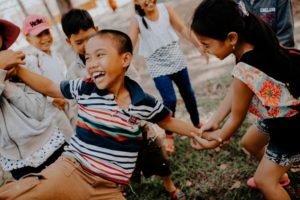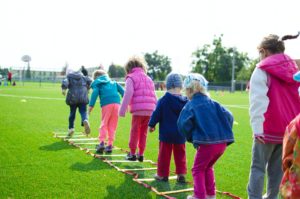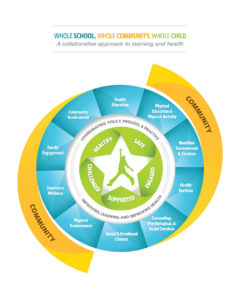Failing Gym is like Failing Lunch or Recess
by Hal A. Lawson
School Physical Education (PE) programs became fixtures in America’s school systems in the first half of the 20th Century. Since then state education department policy standards across the nation have provided commonalities and similarities
Nevertheless, PE practice varies considerably across schools and districts because district central officers, principals, and PE teachers enjoy considerable discretion regarding local policies and program designs. For example, PE tends to be last on the priority list when completing block scheduling. This can result in large, heterogenous PE classes that challenge the most talented teachers. Those who decide to “roll out the ball and watch the students play” have opted for an adaptive strategy in response to sub-optimal conditions over which they have little or no control.
The aim for this blog is to articulate an agenda to better serve students and dedicated PE teachers who need and deserve better working conditions, more resources, and solid policy supports. This blog’s title—a quote from a parent—provides the impetus. This parent’s plea signals an unfinished policy, practice, and research agenda with implications for many stakeholders. These stakeholders start with students, parents, district officers and school leaders, PE teachers, teacher educators, and policy makers and includes public health professionals, parks and recreation leaders, child- and youth-serving community agencies such as YMCAs and Boys and Girls Clubs, and organizers of community youth sports.
 Controversy is inescapable, but this is not news to anyone associated with America’s school systems or the Physical Education profession. After all, school PE is nested in the intersection of three prominent social institutions: The education system, the sport system, and the public health system. The sport system has been especially prominent, in part because PE teachers also coach interscholastic teams. All in all, competing constituencies with diverse goals are predictable, and some are especially influential. Sport enthusiasts and coaches top the list of influencers.
Controversy is inescapable, but this is not news to anyone associated with America’s school systems or the Physical Education profession. After all, school PE is nested in the intersection of three prominent social institutions: The education system, the sport system, and the public health system. The sport system has been especially prominent, in part because PE teachers also coach interscholastic teams. All in all, competing constituencies with diverse goals are predictable, and some are especially influential. Sport enthusiasts and coaches top the list of influencers.
Consider, for example, proposals to consolidate rural school systems, especially those proposals that have been defeated. Oftentimes the potential loss of local interscholastic athletics programs (an integral part of such schools’ and communities’ identities) is a root cause of protests and successful overturns. Coaches, including some who teach PE, are often key players.
What is PE?
Ask multiple stakeholders—superintendents and other district central office staff, principals, classroom teachers, student support professionals, school board members, and parents—for their respective definitions of PE, and you can expect variable answers.
The PE Profession’s Preferred View. Physical Education is a formal school curriculum organized and implemented to disseminate knowledge, values, sensitivities, and skills with immediate importance and use for students. PE teachers are specifically prepared by colleges and universities and certified by the state to enact that curriculum.
Like other “play-like” school subjects—art, music, drama, and dance—learning is the priority, and it proceeds as students perform under a dedicated, competent teacher’s guidance. Gymnasia, aquatic facilities, and playing fields are to PE what studios, theaters, and other special facilities are to the arts. All also are special in another way: They tend to attract and engage students who oftentimes are lured by risky pursuits.
Also like these other special subjects, PE’s grand aim encompasses students’ later lives. Ideally, PE encourages active, health-enhancing lifestyles among young people—with claims that activity today stretches into adulthood.
PE as Minutes of Physical Activity Participation. In another view, a familiar synonym for PE—gym class—signals special status, widespread confusion regarding optimal practices and outcomes, and many challenges. For example, the steady conflation of PE with daily physical activity, often mandated in state policy as “minutes per week,” poses persistent challenges for learning-oriented teachers and PE curriculum consultants. It facilitates district and school leaders’ tendencies to count recess as PE in elementary schools, and it makes it easier to assign classroom teachers instead of specialists.
PE as Interscholastic Athletics. Another routine conflation begins in middle schools that offer interscholastic sports and continues through high school. In this view, PE is essentially an activity-based curriculum, one that privileges sports and games. Here, highly skilled PE students also participate in the school’s competitive teams. Other familiar fixtures in this pattern are PE teachers who do double duty as interscholastic coaches; who recruit athletes from their classes and excuse them from PE participation; and whose career orientations are toward coaching, because the rewards might be seen as greater than the benefits of teaching.
The Cafeteria Curriculum. The inherited, still-dominant PE curriculum is the multi-activity curriculum. It might be better named “the cafeteria curriculum” because it is structured to offer a range of alternatives with the hope that, like alternative kinds of food, every student will find one or more activities they like. Unlike the school cafeteria, where students can pass up food opportunities, PE is like forced eating. If students do not like the fit between the activity and their identities and preferences, an unfavorable grade is among the consequences. Sub-optimal PE experiences and low grades often have immediate and long-term consequences, as some research demonstrates.
Research-Supported PE Programs. Fortunately, research-supported (i.e., evidence-based) school PE curricula are available. A selective sample includes the following:
- Teaching personal and social responsibility, a model that dovetails with social-emotional learning programs
- Teaching games for understanding
- The SPARK curriculum
- A Sport Education Model
- An afterschool model called PAL
- The Joy of Moving
There are other research-based program models, and each has its own justifications, designated conditions and resources, and preferred learning and instructional strategies.
 Specialization is needed. Significantly, all such formal, research-based models necessitate extensive, in-depth teacher training. All also carry with them implementation requirements and resources, starting with time in the curriculum and class sizes/compositions that are conducive to high quality pedagogy and student learning.
Specialization is needed. Significantly, all such formal, research-based models necessitate extensive, in-depth teacher training. All also carry with them implementation requirements and resources, starting with time in the curriculum and class sizes/compositions that are conducive to high quality pedagogy and student learning.
Choices thus are inescapable, beginning in PE teacher education programs and extending to schools and their district offices. Although these choices present formidable challenges, the rapid development of alternative kinds of schools provides opportunities beyond “one size fits all gym class.” These choices also compel solid partnerships between teacher education programs and schools, enabling them to learn, innovate and improve together.
The Challenges during a Pandemic
Many, perhaps most, experts agree that today’s mass home schooling and remote learning are not merely temporary responses to a crisis. They are portents for new institutional designs for schools and the broader concept of education because they signal that education and learning transcend place-based, custodial schooling.
PE is an important case in point. Children, youths, parents, educators, and other adults have had to cope with the challenges of physical distancing requirements that can lead to less physical activity and more sedentary living. Undesirable results include weight gain and mental health issues. Regular, health-enhancing physical activity is both a preventive mechanism and a timely response. However, kids lack access to supervised recess and structured PE classes.
Creative people are developing innovative solutions to this challenge. For example, the University at Albany’s RemoteEd site provides physical activity resources for students, teachers, parents, and others.
An important policy resource that can help guide families, schools, and communities is a national report card on physical activity for children and youth with state-by-state scores. More importantly, it provides recommendations for healthy activities that can be undertaken by schools, other child-care organizations, and families to combat the ill-effects of too much sitting.
All such choices about improving physical activity for the young are especially consequential today, as physical distancing encourages the trend among youth to spend increasing amounts of time indoors and on screens. Something must be done. Active, health-enhancing lifestyles and the well-being of America’s children and youths hang in the balance.
Framing the Challenges-as-Opportunities for Timely Innovations
As districts and their schools prepare for an eventual reopening, planning for the PE curriculum can be part of their plans. Two important reminders, once joined, offer improvement ideas and innovation pathways.
First: Although every student will not be an athlete, all have bodies, and all need to adopt and continue health-enhancing, active lifestyles. Second: PE teachers working alone and without needed supports and resources cannot lay claim to the full range of societal determinants and influences on health-enhancing, active lifestyles among America’s young people. Collective action strategies are needed, including partnerships with community agencies, youth sports programs, and families.
 Young people challenged by poverty, social exclusion, and social isolation; who oftentimes are home alone; and whose neighborhood environments are unsafe for outdoor play are special priorities. Whereas students from well-to-do families often have access to instruction and participation outside of school, school programs may be akin to the “only show in town” for considerable numbers of students. In some communities, schools serve as community hubs and are likely to continue to do so when stay-at-home restrictions are eased. PE programs bearing many names have been centerpieces of their programming.
Young people challenged by poverty, social exclusion, and social isolation; who oftentimes are home alone; and whose neighborhood environments are unsafe for outdoor play are special priorities. Whereas students from well-to-do families often have access to instruction and participation outside of school, school programs may be akin to the “only show in town” for considerable numbers of students. In some communities, schools serve as community hubs and are likely to continue to do so when stay-at-home restrictions are eased. PE programs bearing many names have been centerpieces of their programming.
Out-of-school time programs, featured in a recent NYKids blog, are convenient, timely candidates for innovation. An attractive, theoretically sound national framework called the Whole School, Whole Community, Whole Child model offers practice, policy, and overall capacity-building guidance.
Creating Desirable Futures for Students
The late management guru, Peter Drucker, recommended that planning for the future should start with a theory of planned abandonment. It is facilitated by a generative question. If we hadn’t inherited it, would we do it this way?
If we hadn’t inherited today’s PE, starting with school programs and extending to state and district policies and PE teacher education, would we do it in the same way?
Several years ago, educational leaders in Australia asked comparable questions. They examined futures forecasting models as they tried to anticipate what life and living would be like fifty or more years into the future. Their explorations focused on what today’s young people would need to learn and do today to thrive in tomorrow’s world.
Australia’s leaders concluded that significant revisions and consequential innovations were in order for schools and special subjects such as PE and health education. Their journey toward the implementation of a futures-creating agenda for PE, health education, and schools is instructive for all concerned citizens.
Perhaps the timing is right for a comparable agenda in New York. NYKids’ equity-focused research—past, present, and future—can be marshalled in support. Imagine “gym class,” carefully designed and no longer equated with recess and lunch, as a magnet for student engagement; and also as a preparation for a healthy life beyond school. A sound, research-based PE curriculum can also be a hook for academic achievement and a facilitator for college and career readiness!
